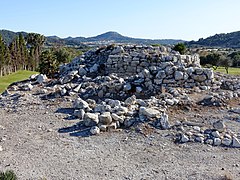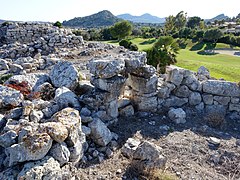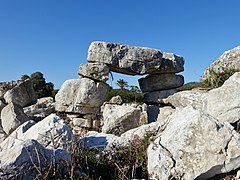Talaiot de Pula
| Talaiot de Pula | ||
|---|---|---|
|
West side of the stepped Talaiot de Pula |
||
|
Location in Mallorca |
||
| Coordinates | 39 ° 38 '41.8 " N , 3 ° 22' 43.1" E | |
| place | Son Servera , Balearic Islands , Spain | |
| Emergence | 9th century BC Chr. | |
The Talaiot de Pula is a prehistoric tower on the Spanish Balearic island of Mallorca . It stands in the middle of the golf course Pula Golf in the municipality of Son Servera in the region ( Comarca ) Llevant . The talaiot (from the Catalan word talaia for "observation and watchtower"), built on a circular plan , has been preserved in the lower part. The building is attributed to the Iron Age Talaiot culture (also Talayot culture), which Mallorca from 9th to 6th century BC. BC coined.
location
The Talaiot de Pula is about 63 meters above sea level , 640 meters southeast of the summit of the almost 182 meter high Puig de Son Pentinat . The east coast of Mallorca at Port Vell on the Badia de Son Servera is 2.3 kilometers away. The MA-4040 road, which connects Son Servera with Capdepera , runs about 90 meters northwest of the Talaiot . It divides the golf course, on whose grounds the Talaiot de Pula is located, into a smaller western and a larger eastern area. About 250 meters north of the Talaiot, an underpass under the road connects the two parts of the golf course. From the confluence of a paved path that leads further east, the golf course is freely accessible and the location of the Talaiot can be reached.
description
Among the towers of the Talaiotic culture, a distinction is made between square and round structures (Catalan talaiot square and talaiot circular ). The structure of the Talaiot de Pula is a round tower. However, it has a few extensions, including a kidney-shaped extension with three column bases in the northeast, which make it appear step-shaped, which is why it is also known as a stepped talaiot (Catalan talaiot escalonat , Castilian talayot escalonado ). The construction is dry masonry , which means that the stone blocks were stacked on top of one another without the use of connecting material. The irregular stones of the walls are of different sizes and not set in horizontal rows.
Ten meters northeast of the kidney-shaped extension of the Talaiot de Pula are the remains of another round Talaiot. Only a few parts of the outer wall with a southern “ lintel ” have survived. The purpose of the opening is unknown; generally speaking, this type of tower construction assumes access to the interior. In the center of the structure lies a single large stone in the ground, which, like other talaiots, may have supported a column of stones stacked on top of one another as a support for a roof. Such middle stone pillars are preserved in the talaiot of the prehistoric village of S'Hospitalet Vell as well as in the round talaiot of the talaiotic settlement of Sa Canova .
Both talaiots from Pula were excavated by Guillermo Rosselló Bordoy in the late 1960s . There was plenty of ceramics and a fireplace . The beginning of the talaiotic is assumed to be the time of construction of the talaiots, which after the revision of earlier chronologies from the 9th to 6th centuries BC. Chr. Was enough. Two radiocarbon dates of found charcoal are far apart. Rosselló's sample delivered 1510 ± 60 BC in the 1970s. BC, William Waldrens in the 1980s 819 ± 20 BC The first value is not considered representative today. Since 1966 the archaeological site has been registered as Talaiot de Pula / Davant ses cases under the number RI-51-00029832 as an archaeological monument (Monument arqueològic) .
- Views of the stepped talaiot
- Views of the northeast talaiot
Individual evidence
- ↑ Senderisme a Mallorca. Consell de Mallorca, accessed on August 2, 2016 (interactive map).
- ↑ a b c Pula. Un talayot escalonado junto a los restos de uno circular. www.talayots.es, November 24, 2009, accessed August 2, 2016 (Spanish).
- ↑ Jaciments Arqueològics. Polígon 18 . In: Catàleg de Patrimoni Històric, Artístic, Arquitectònic i Paisatgístic de Son Servera . 2009, Pula: Element número 2027, 3rd Descripció de l'Element, p. 91 (Catalan, digitized version [PDF; accessed on August 2, 2016]). Digitized version ( memento from July 29, 2016 in the Internet Archive )
- ^ Rafael Micó: Radiocarbon Dating and Balearic Prehistory: Reviewing the Periodization of the Prehistoric Sequence . In: RADIOCARBON . tape 48 , no. 3 , 2006, p. 421–434 (English, digital version [PDF; 2.2 MB ; accessed on October 5, 2016]).
- ↑ Manuel Fernández-Miranda: Aspects of Talayotic Culture . In: Miriam S. Balmuth, Antonio Gilman, Lourdes Prados-Torreira (eds.): Encounters and Transformations: The Archeology of Iberia in Transition (= Monographs in Mediterranean Archeology . No. 7 ). Sheffield Academic Press, Sheffield 1997, ISBN 978-1-85075-593-7 , pp. 59 (English, digitized version [accessed on August 2, 2016]).
- ↑ a b Víctor M. Guerrero Ayuso, Manuel Calvo Trias, Bartomeu Salvà Simonet: La Cultura Talayótica: una sociedad de la Edad del Hierro en la periferia de la colonización fenicia . In: Complutum . tape 13 , 2002, p. 221–258 (Spanish, digitized [PDF; 2.1 MB ; accessed on October 5, 2016]).
- ^ William H. Waldren: Balearic Pentapartite Division of Prehistory. Radiocarbon and other Age determination inventories , BAR, Int. Series 282, Oxford 1986 (English).
- ↑ Lista del Ministerio del Interior. WML files. wmflabs.org, accessed August 2, 2016 .
- ↑ Jaciments Arqueològics. Polígon 18 . In: Catàleg de Patrimoni Històric, Artístic, Arquitectònic i Paisatgístic de Son Servera . 2009, Pula: Element número 2027, 3rd Descripció de l'Element, p. 92 (Catalan). PDF ( Memento from July 29, 2016 in the Internet Archive )
Web links
- Archaeological sites of the municipality of Son Servera. 2018, accessed May 28, 2018 (Catalan).











